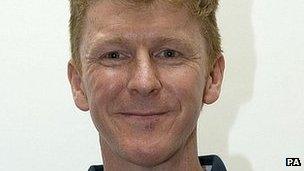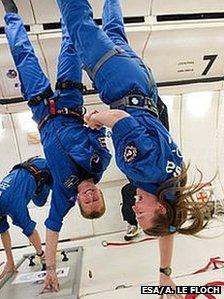Major Tim Peake says he is not too old to go into space
- Published

The 40-year-old astronaut says there is still plenty of time for him to be assigned a space mission
The UK's first official astronaut in training says he is not too old - at the age of 40 - to go into space.
Major Tim Peake, from Salisbury, was accepted into the European Space Agency (Esa) in 2009 at the age of 37.
Since then he has undergone astronaut basic training, practised spacewalking, experienced zero gravity flights and spent 12 days in an underwater lab.
Now he says he is looking forward "to that day when hopefully I'll get launched into space".
Major Peake, a former helicopter pilot in the Army Air Corps, is the first Briton to be appointed by the European Space Agency (Esa) Astronaut Corps.
One of six new recruits, chosen from more than 8,400 candidates, he will also be the "UK's first official astronaut in space" when he finally gets into orbit.
But since his selection in 2009, his astronaut training - including learning Russian so he can work on the space station - has kept him on the ground.
"No, it doesn't get frustrating at all - there's just so much going on, so much diversity and there's brilliant training all along the way," he said.
'Plenty of time'
"And I've got quite a bit of time actually.
"The average age of an astronaut is quite high, it's up in the high 40s if not low 50s, because you have to attain so much experience before being selected and then the training takes so long.
"And I've got a career until I'm 63. So there's still plenty of time, I hope, to get my mission in and maybe even more than one mission."

Major Tim Peake and Dr Gail Iles floating upside down on a zero-g flight
In 2010, Major Peake - who is married with two sons - and the new intake of astronauts graduated from basic training.
They are the first group of candidates Esa has put through a training programme of its own design at its centre in Cologne, Germany.
It was a programme that included engineering familiarisation, medical, survival and robotics training as well as microgravity or "zero-g" flights and sessions in a giant pool practising spacewalking.
'Dream come true'
Now Major Peake, as he waits to be assigned a space mission, is in an ongoing programme of spacesuit training, zero-g flights to "practice weightlessness" and 12-day stints 20m (65ft) under water to research "crew behaviour for long-duration missions".
"I've yet to have a day where I'm bored in this job," he said.
"It's a very diverse training programme, from learning about the Soyuz spacecraft - because that's going to be the vehicle that gets us into space - to learning about the space station and how to maintain it.
"As well as more unusual things like survival training, in case we land in the wrong location, living in a cave, living underwater and practicing those psychological elements to long duration space flights."
Following the retirement of the US space shuttle in 2011, the only way to transfer astronauts to the International Space Station (ISS) is aboard the three-seat Russian Soyuz vehicle.
But as a partner on the ISS programme, and following an agreement to extend space station operations until 2020, Europe has the right to claim a long-duration ISS residency of six months roughly every two years.
"We're quite fortunate in the European Space Agency we've got a good track record of assigning our astronauts," he said.
"Of my class of six in 2009 three have already been assigned and we have three spare missions waiting to be assigned between now and 2020.
"It's just a matter of keeping fit and waiting for your opportunity to be assigned to a flight - which will be the ultimate dream come true."
Helen Sharman was the first Briton in space in 1991, but she had to raise the money needed to fly on a Russian spacecraft herself.
Three other astronauts who've flown into space were born in Britain but made the journey as American residents.
- Published14 August 2012
- Published11 June 2012
- Published22 November 2010